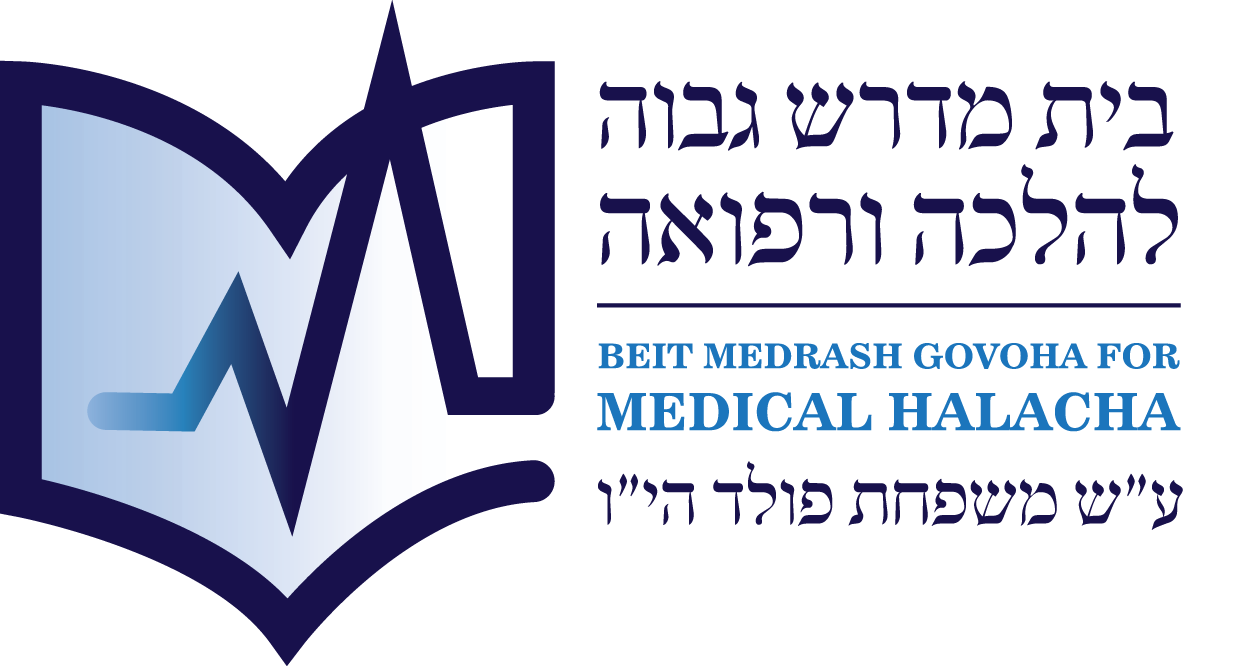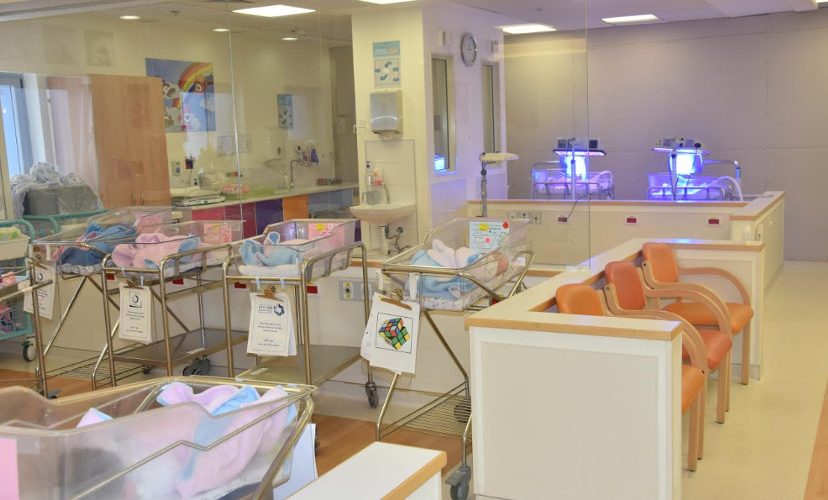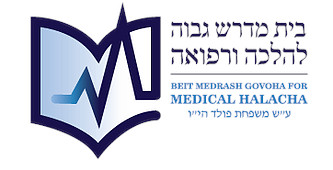Many nurses have asked recently about performing the newborn metabolic screening test on Shabbos. Newborn screening is intended to detect an extensive list of serious but treatable medical conditions.[1] Early diagnosis of these disorders enables initiation of therapy and supports healthy development. In the United States, this test is performed 24-48 hours after birth; in Israel, the official guidelines are to obtain the sample for testing at least 36 hours after birth and before discharge from the hospital, preferably after the baby has begun eating. The results of testing are generally available after 14 days.
A blood sample is obtained by pricking the infant’s heel and squeezing gently to extract four drops of blood that are applied to a Guthrie card, staining the white card red. To reduce the risk of contamination from skin debris or alcohol residue, the first drop is wiped away with gauze, and the subsequent drops are used to saturate the filter paper for testing.
At Shaare Zedek Medical Center, I have instructed that tests for infants within the required time frame be performed only after Shabbos concludes, not on Shabbos itself. However, in other medical institutions, the prevailing practice is to perform the tests per routine, as on any weekday, despite the absence of any medical need to collect the samples specifically at that time. In any case, the central laboratory of the Ministry of Health does not collect the samples obtained on Shabbos until Sunday morning.
What should Shomer Shabbos nurses working in hospitals where newborn screening is routinely performed on Shabbos do to address concerns of Chillul Shabbos?
First, we must explain why performing this test is prohibited on Shabbos.
Drawing Blood:
Drawing blood from animals or humans is a Melacha and Asur Min haTorah. According to the Rambam (Hilchos Shabbos 8:7), it falls under the category of Dash (threshing), as the blood is removed from its natural place within the body, akin to extracting grain from kernels. According to Rashi and Tosfos (Shabbos 107), it falls under the category of Netilas Neshama (taking a life). Since blood is equated with life, drawing blood is akin to taking the soul.
The Nafka Mina between these opinions lies in the required measure for incurring a Chatas. Most Rishonim hold that any amount of blood is sufficient to incur the penalty for Netilas Neshama. Still, one is not liable for violating the Melacha of Dash (a derivative of threshing) unless he extracts a volume equivalent to a dried fig (Grogeres). This distinction is explicitly stated by the Rambam (ibid.). However, all opinions agree that the act is an Issur d’Oraisa even when a minimal amount of blood is drawn.[2]
In many halachic discussions, drawing blood is categorized as a Melacha sheEina Tzricha l’Gufa (a Melacha performed for an incidental outcome) since the intent is not to use the blood but to remove it from the body.[3] However, a blood test is the perfect example of a Melacha performed for its own sake (Tzricha l’Gufa), since the blood is required for diagnostic purposes. This classification is universally accepted by all major halachic authorities and is articulated in Or l’Tzion (2), Shemiras Shabbos Kehilchasa (32, footnote 158), and Orchos Shabbos (2, pp. 528–529).
Additionally, drawing blood by applying pressure near the puncture site and squeezing out the blood presents a greater halachic concern of Mefarek (extraction, a derivative of Meleches Dash) than when blood drains from an incision. This is implied by Rashi in Shabbos 75a regarding squeezing the Chilazon: “One who squeezes it presses it with his hands to extract its blood.”
This was also pointed out by haGaon Rav Asher Weiss Shlit”a (Minchas Asher, 1:20). He cites the Eglei Tal[4] (Dash 15), who maintains that one is not liable for Mefarek unless an act is performed directly on the inner substance extracted and exposed, as in threshing, where the stalks are struck to release the grain.
Rav Asher makes two points:
- The Rishonim who disagreed with the Rambam and did not define Chovel as a subset of Mefarek based their ruling on the absence of direct manual pressure to extract blood in a typical injury where one strikes another and causes bleeding.
- Even the Rambam may agree that using a syringe to extract blood is not considered Mefarek, as it is not the same direct physical pressure as threshing.
Given these considerations, drawing blood for diagnostic testing may violate both Mefarek and Netilas Neshama.
Staining the Guthrie card:
Staining the white filter paper of the Guthrie card with blood raises concerns of Tzove’a.
The Poskim deliberate whether one may bandage a wound with fabric that will become bloodstained. Many permit this in urgent situations since the staining is unintended and damages the fabric. See Mishna Berura 328:146.
However, this case is significantly different as the staining is both intentional and essential, as it is precisely how the card is intended to be used. Moreover, the card is not discarded immediately, but retained for several days for laboratory analysis. While one could debate this, the act already constitutes a Torah-level prohibition due to the blood extraction itself, as noted above. Therefore, performing the newborn screening test involves an Issur d’Oraisa and additional Issurim d’Rabbanan. It should not be performed on Shabbos except in cases of Pikuach Nefesh.
The next issue to address is whether delaying the test until after Shabbos is a matter of Pikuach Nefesh. Even if we assume that the [ideal] window for performing the test will have elapsed by then, the likelihood that a particular infant suffers from one of the serious conditions screened for is relatively low. On the other hand, if the infant does indeed have one of those conditions, timely diagnosis enables treatment that constitutes Pikuach Nefesh. Delayed identification may pose significant danger to its health.
If this were merely a question concerning an individual infant, we could argue that performing the test does not constitute Pikuach Nefesh, as there is no specific reason to suspect that this particular baby is unwell, and the diseases in question are quite rare. (This reasoning is explicitly based on the rarity of the condition and not on the infant’s apparent health. If we knew that an infant had one of these conditions, even if there are no clinical symptoms at present, it would be considered a Choleh sheYesh Bo Sakana and Shabbos should be desecrated for any medical needs required for its care.)
However, if we were to apply this logic uniformly to all infants, we would ultimately be allowing seriously ill babies to go undiagnosed and risking their health. Whenever dealing with a public healthcare system, we must act according to principles of Pikuach Nefesh, doing everything possible to minimize potential risks. Even a protocol that saves a single infant places the entire process within the halachic category of Pikuach Nefesh.
This concept has already been clarified by Rav Asher, who explained that the ruling of the Magen Avraham (O.C. 316:23) and R’ Akiva Eger (Shu”t Kama 60) that a one-in-a-thousand chance of Sakana does not constitute Pikuach Nefesh applies only in the context of isolated individual danger, not to questions involving public health.
For example, Halacha permits the desecration of Shabbos for a woman in labor, even though statistically only “one in a thousand” may die from childbirth, as stated by the Magid Mishna (Hilchos Shabbos 2:11). The Magen Avraham cites this ruling in Orach Chaim 330:3. We are therefore compelled to distinguish between individual cases and systemic realities.
As Rav Asher wrote: “Could we possibly accept with equanimity the death of one out of every thousand birthing mothers, when it is within our power to prevent it? Would any hospital willingly accept a protocol in which one out of every thousand women dies in childbirth, simply because the other nine hundred and ninety-nine deliver safely?”
It is important to emphasize that the potential lifesaving outcome of identifying a sick infant is not a distant or hypothetical concern, as treatment begins immediately upon diagnosis. Therefore, this situation does not fall under the rulings of the Noda b’Yehuda (Tinyana, Y.D. 210) and Chasam Sofer (Y.D. 336), that the halachic category of Pikuach Nefesh is not applied in the absence of an actual patient. In our case, the situation is tantamount to having a Choleh “b’Faneinu”.
Furthermore, even the Chazon Ish (Y.D. 198), who rules that the distinction lies in whether the potential rescue is near or distant, would likely agree that the rescue is considered immediate and present in this case. The remaining question is the degree of risk involved and whether investigating that risk qualifies as Pikuach Nefesh. While the probability of danger may be uncertain, the resulting harm from delayed disease identification would be both immediate and severe.
Therefore, in the case of infants for whom the 72-hour window for testing will expire before the end of Shabbos, one is permitted to perform the test on Shabbos. Although the majority of infants are tested within the proper timeframe, we are not allowed to be lax in the execution of these screenings. On the contrary, great care must be taken to ensure all infants are tested. The effort to guarantee complete testing coverage must be treated as a matter of Pikuach Nefesh.
Nursing shifts in hospitals worldwide are generally divided into three 8-hour shifts: 7:00 a.m. to 3:00 p.m., 3:00 p.m. to 11:00 p.m., and 11:00 p.m. to the following morning. It seems that a nurse assigned to a Friday daytime shift is obligated to perform as many tests as possible to minimize the need for Shabbat desecration by others. Suppose she is working the Friday evening shift, which extends into Shabbos. In that case, there is an added responsibility to ensure that any newborns for whom she will be responsible during this shift (or in a subsequent shift that Shabbos) are tested before Shabbos. Likewise, it is self-evident that if a nurse works the Shabbos afternoon shift that continues into Motzaei Shabbos, she should delay performing these tests until after Shabbos.
If a nurse is working the Friday night or Shabbos morning shift, or where she began working on Friday and continued into Shabbos, but did not manage to test the newborns before Shabbos started, what should she do? There will still be ample time after Shabbos to conduct the testing, but hospital protocols stipulate that she is responsible for performing the test during her shift. Further halachic clarification is needed to determine her obligation in such a case.
Generally speaking, any action that is considered Pikuach Nefesh but can be deferred until after Shabbos without endangering life does not override Shabbos. This principle is stated clearly by the Shulchan Aruch haRav (O.C. 328:4).
R’ Yehoshua Neuwirth zt”l also addresses this issue in Shemiras Shabbos Kehilchasa (36: 12):
Immediately after birth, several procedures are performed on the infant. One must distinguish between those that are of direct medical necessity and pertain to the baby’s immediate health – which are certainly obligatory – and other procedures, such as weighing, which should be done using a mechanical scale, not a digital one. But there is no justification for performing medical screenings, such as for genetic diseases or thyroid function, on Shabbos.
Although Rabbi Neuwirth does not explain this ruling explicitly, it appears that his reasoning is that so long as the test does not require immediate performance – and can be delayed without risking the infant’s health – there is no compelling reason to perform it on Shabbos.
He addresses routine medical procedures in two additional locations. In Chapter 40, Se’if 38, regarding medical tests and imaging, he rules that these may be permitted on Shabbos for reasons of Pikuach Nefesh, but adds:
There is no justification for performing tests or imaging on Shabbos merelydue to routine or for resolving legal issues. In such cases, one must wait until after Shabbos, even if financial loss is involved.
However, in Se’if 28 of the same chapter, he writes:
In a hospital where the nurses work in shifts, and if the day shift leaves treatments for the night shift, this could delay procedures planned for the night and endanger patients; it is permissible to administer treatment on Shabbos during the day. It is commendable for the hospital administration to consult with a halachic authority to avoid turning Shabbos into a regular weekday.
Performing nonurgent medical procedures on Shabbos is justified only if delaying the treatments until after Shabbos might disrupt or delay other scheduled treatments scheduled after Shabbos. We must also add cases where there is concern that the treatment might be forgotten or overlooked altogether. This is the basis for halachic leniencies related to medical recordkeeping on Shabbat.
It is important to underscore this point, as in recent years there has emerged a prevailing attitude that seems to permit any medical protocol to be performed strictly according to its scheduled time, based solely on the institutional workflows, without any assessment of the actual necessity of the procedure from a halachic standpoint. In my opinion, such an approach represents a serious breach in the sanctity of Shabbos and lacks a solid halachic foundation.
The appropriate considerations, as outlined above, must include the following two assessments:
- Will postponing the procedure until after Shabbat interfere with or delay other necessary treatments?
- Is there a risk that delaying the procedure until after Shabbos might result in it being forgotten or omitted altogether?
In the present case, it seems clear that neither concern applies. The procedure in question is conducted in the newborn nursery of the maternity ward, which is not characterized by the intense, high-paced activity found in other hospital departments and generally operates in a calm, routine manner. Performing the test either on Shabbos or after Shabbos does not compromise the unit’s function nor the care of the newborns.
Even on Motzaei Shabbos during the summer months, with proper organization, the tests and any discharges postponed due to Shabbos can be handled efficiently and without compromising care. This is particularly true as infants scheduled to be discharged on Motzaei Shabbat can be tested on Friday.
Moreover, there is no concern that the test will be forgotten or missed, as modern computerized systems track whether a particular infant has undergone the screening, which is verified before discharge.
Finally, many nurses working in medical centers with a standing directive to perform these tests on Shabbos have asked how they should conduct themselves when expected to carry them out. Since there is no halachic basis for leniency in this matter, the answer is as the Pasuk says: “A prudent person acts with knowledge” (Mishlei 13:16). That is, one should seek out practical and creative solutions to avoid having to perform the test oneself.
For instance:
- A nurse working the Friday afternoon or Shabbos afternoon shift can arrange to perform the tests before or after Shabbos.
- If she is scheduled for the Shabbos morning shift, she should try to ensure that the infants who can be tested before Shabbos (whether by her during an earlier shift or by others) are tested in advance, thereby reducing the number of tests required on Shabbos.
- If a non-Jewish nurse is working that shift, she can try to arrange for that nurse to perform the tests.
However, under no circumstances should the test be performed by the Jewish nurse herself, even with a Shinui. Generally, any procedure performed directly on the human body cannot be done even with a Shinuiunder non-Pikuach Nefesh circumstances.
May those who strive to uphold Halacha merit Si’ata diShmaya, avoid halachic pitfalls, and earn their Parnasa free from halachic conflicts.
[1] In the United States, states choose which disorders to include in newborn screening, but the official recommendation includes a core set of 31 congenital conditions. These include phenylketonuria (PKU), congenital hypothyroidism, sickle cell disease, cystic fibrosis, spinal muscular atrophy (SMA), and severe combined immunodeficiency (SCID). Israel initially screened for just PKU and congenital hypothyroidism, but have expanded the panel to include congenital adrenal hyperplasia (CAH), maple syrup urine disease, homocystinuria, tyrosinemia, and SCID, among others.
[2] [Editor’s note: This is because we rule like R’ Yochanan that Chatzi Shiur Asur Min haTorah. Further discussion is beyond the scope of this essay.]
[3] [Editor’s note: For example, draining a hematoma.]
[4] R’ Avraham Borenstein zt”l (1838-1910), author of Avnei Neizer and the first Admo”r of Sochatchov.










Add comment